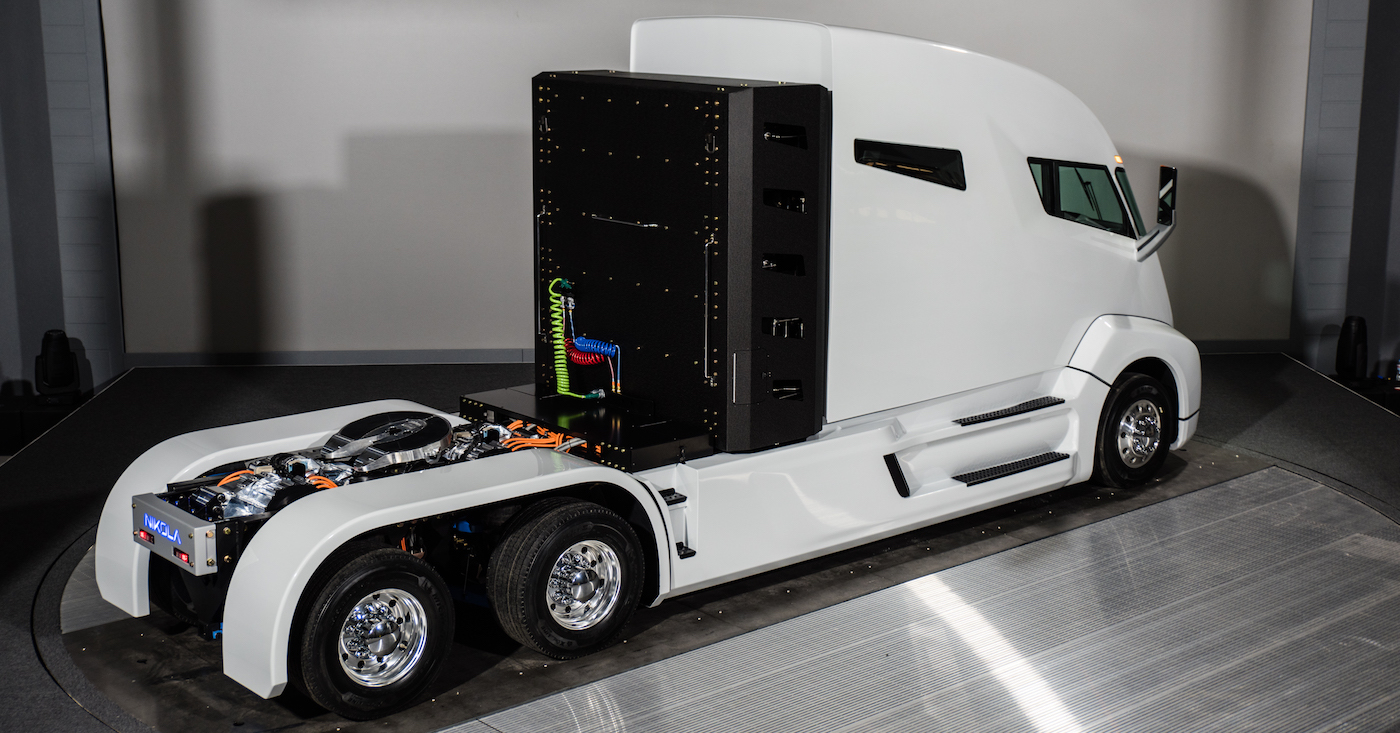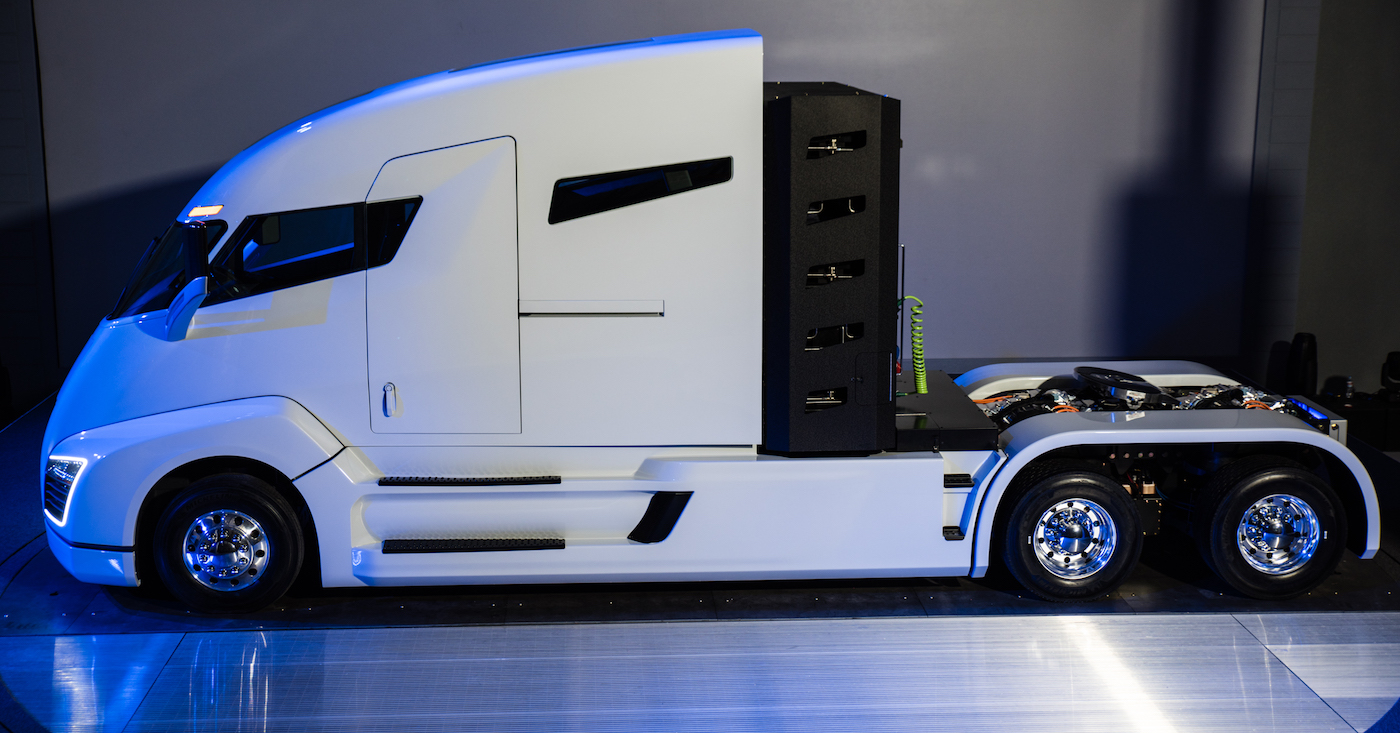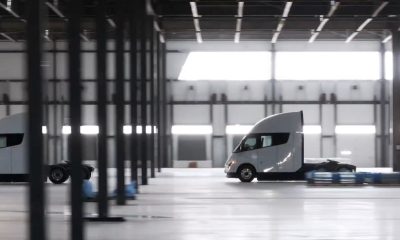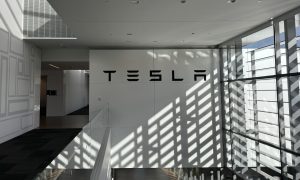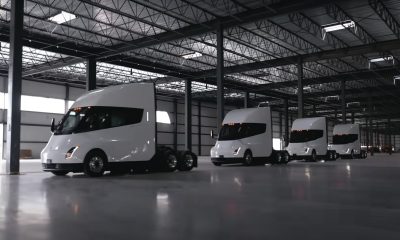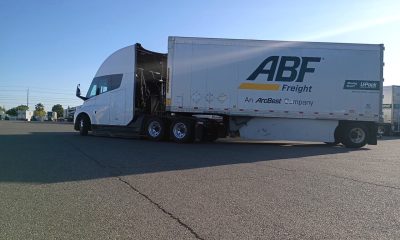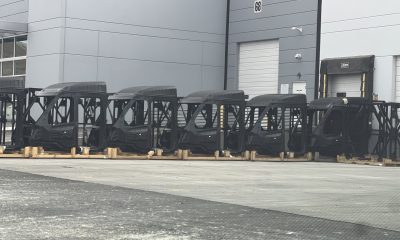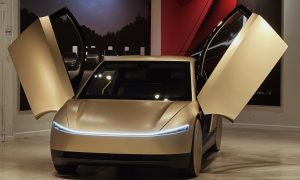News
Nikola Motor unveils 1,000 HP hydrogen-electric truck with 1,200 mi. range
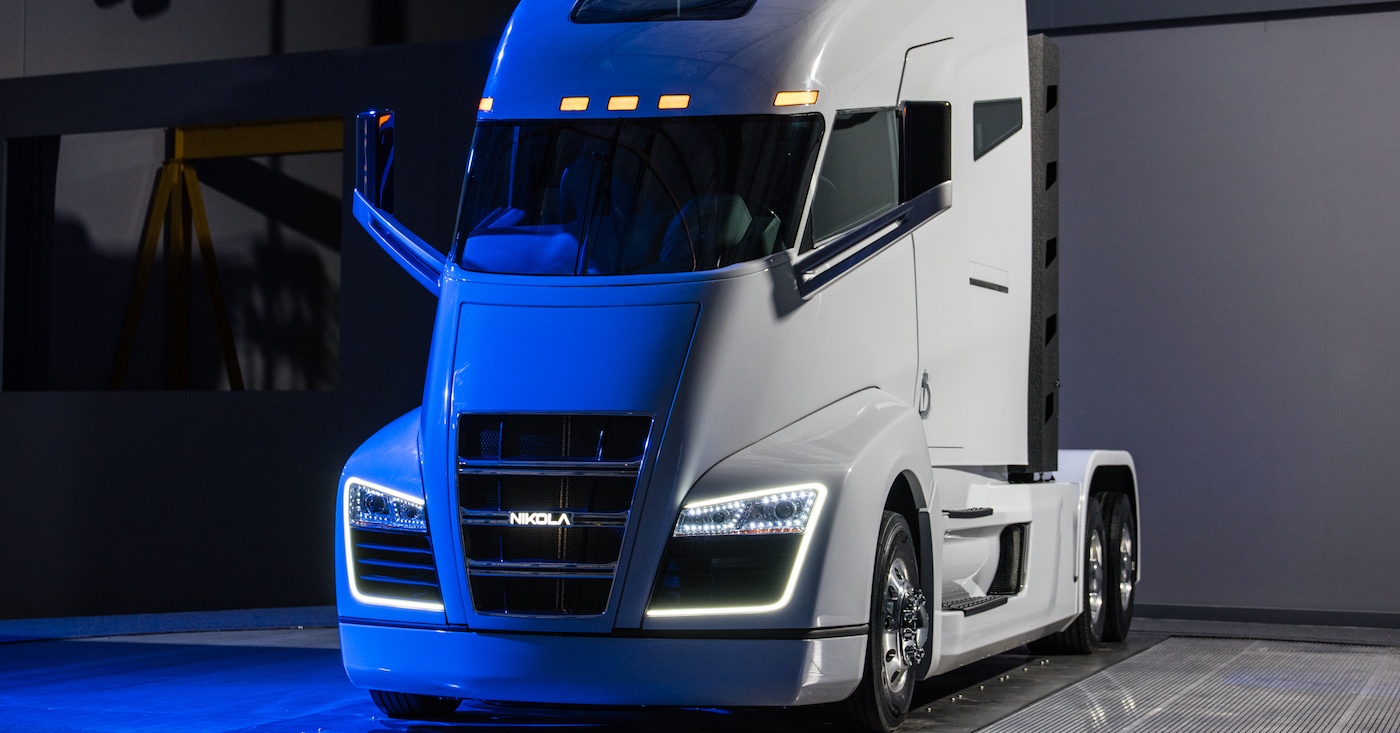
Nikola Motor Company unveiled its zero emissions Class 8 truck at company headquarters this week. Dubbed the Nikola One, the once all-electric prototype now hydrogen powered, boasts an incredible 1,200 miles of range and will be stiff competition for Tesla’s planned entry into the long haul trucking segment with its all-electric Tesla Semi.
Nikola One is sleek and futuristic. Because it has no diesel engine, the cab can be pushed forward as far as possible to give the driver a panoramic view of the road ahead. Individual electric motors for each of its six wheels provides an incredible 1,000 horsepower and 2,000 lb-ft of torque. Both numbers are considerably higher than for a typical tractor.
Power comes from a 320 kWh battery developed by the company. “Our battery engineers have made major advances in storage and cooling,” said Nikola founder and CEO Trevor Milton. “We believe our lithium battery packs are more energy dense and weigh less than any available vehicle production pack per kWh.”
The company had previously designed Nikola One as an electric truck that would have a range extender via a turbine powered by natural gas. But at the reveal, the company announced the turbine has been replaced by a hydrogen fuel cell that will keep the battery charged and provide a range between 800 to 1,200 miles.
The prototype on display this week is technological marvel. An array of sensors and cameras permit the driver to have a full 360º view around the entire rig at all times, eliminating blind spots all together. Inside the cab there is room for a one or two full size beds, a refrigerator/freezer, a 40″ curved 4K TV with Apple TV, as well as Wi-Fi and 4G LTE connectivity. Comfort and convenience for the driver will be unparalleled.
The company says it is evaluating a number of locations for its factory. “Nikola will build a world-class advanced manufacturing facility which will create thousands of new jobs,” says Trevor Milton. He claims the factory will be able to build 50,000 trucks a year by 2020.
So far, one might be forgiven for thinking the Nikola One is mostly vaporware except for one thing. The company has struck a deal with Ryder Systems, which has agreed to be Nikola’s exclusive nationwide distribution and maintenance provider. Ryder has a network of over 800 service locations in North America today.
“We are extremely excited to finally show off the Nikola One to the public for the first time,” said Milton. “There are many out there that wondered if we would deliver, but today we proudly show off the most advanced semi-truck ever built. We couldn’t be more thrilled to have one of the best brands in America, Ryder, as our trusted partner providing nationwide sales, service and warranty for Nikola Motor Company.”
The financial plan for the company calls for leasing the trucks for 72 months at rates of between $5,000 and $7,000 a month. The lease fee will cover all scheduled maintenance at a Ryder facility and the cost of hydrogen fuel. Talking a page from the Tesla playbook, Nikola is accepting reservations for its battery/fuel cell Class 8 truck. It says it has received billions of dollars worth of deposits which cost $1,500 and are fully refundable.
Meanwhile, Elon Musk has let it be known that he also has his eye on the heavy truck market. We can be sure his vision for a Tesla Semi won’t involve any onboard fossil fueled range extender engines or what he dismissively calls “fool cells.”
The Coast of Hydrogen
Nikola says it intends to develop a network of 350 hydrogen fueling stations across North America for its trucks, beginning in 2018. It would be similar to the Supercharger network Tesla has been building to support long distance travel for its fleet of electric cars. But here’s the rub.
Hydrogen refueling stations cost $2 million or more to construct. It is estimated that a typical Tesla Supercharger location costs about one tenth as much to build. Exactly who will be paying for the hydrogen refueling system is unclear. And there are other issues with using hydrogen. Yes, the waste products of a fuel cell are water vapor and heat. But getting the hydrogen requires tremendous amounts of energy.
In the US, most hydrogen is derived from natural gas. Take the process back a step or two and that natural gas is often the result of fracking, a process that at the very least is controversial and at worst results in heavy pollution of the land and groundwater in the vicinity. Whether the Nikola One can accurately be called “zero emissions” is a matter for debate.
Elon Musk
Tesla Supercharger Diner food menu gets a sneak peek as construction closes out
What are you ordering at the Tesla Diner?

The Tesla Supercharger Diner in Los Angeles is nearing completion as construction appears to be winding down significantly. However, the more minor details, such as what the company will serve at its 50s-style diner for food, are starting to be revealed.
Tesla’s Supercharger Diner is set to open soon, seven years after CEO Elon Musk first drafted the idea in a post on X in 2018. Musk has largely come through on most of what he envisioned for the project: the diner, the massive movie screens, and the intended vibe are all present, thanks to the aerial and ground footage shared on social media.
We already know the Diner will be open 24/7, based on decals placed on the front door of the restaurant that were shared earlier this week. We assume that Tesla Optimus will come into play for these long and uninterrupted hours.
The Tesla Diner is basically finished—here’s what it looks like
As far as the food, Tesla does have an email also printed on the front door of the Diner, but we did not receive any response back (yet) about what cuisine it will be offering. We figured it would be nothing fancy and it would be typical diner staples: burgers, fries, wings, milkshakes, etc.
According to pictures taken by @Tesla_lighting_, which were shared by Not a Tesla App, the food will be just that: quick and affordable meals that diners do well. It’s nothing crazy, just typical staples you’d find at any diner, just with a Tesla twist:
Tesla Diner food:
• Burgers
• Fries
• Chicken Wings
• Hot Dogs
• Hand-spun milkshakes
• And more https://t.co/kzFf20YZQq pic.twitter.com/aRv02TzouY— Sawyer Merritt (@SawyerMerritt) July 17, 2025
As the food menu is finalized, we will be sure to share any details Tesla provides, including a full list of what will be served and its prices.
Additionally, the entire property appears to be nearing its final construction stages, and it seems it may even be nearing completion. The movie screens are already up and showing videos of things like SpaceX launches.
There are many cars already using the Superchargers at the restaurant, and employees inside the facility look to be putting the finishing touches on the interior.
🚨 Boots on the ground at the Tesla Diner:
— TESLARATI (@Teslarati) July 17, 2025
It’s almost reminiscent of a Tesla version of a Buc-ee’s, a southern staple convenience store that offers much more than a traditional gas station. Of course, Tesla’s version is futuristic and more catered to the company’s image, but the idea is the same.
It’s a one-stop shop for anything you’d need to recharge as a Tesla owner. Los Angeles building permits have not yet revealed the date for the restaurant’s initial operation, but Tesla may have its eye on a target date that will likely be announced during next week’s Earnings Call.
News
Tesla’s longer Model Y did not scale back requests for this vehicle type from fans
Tesla fans are happy with the new Model Y, but they’re still vocal about the need for something else.
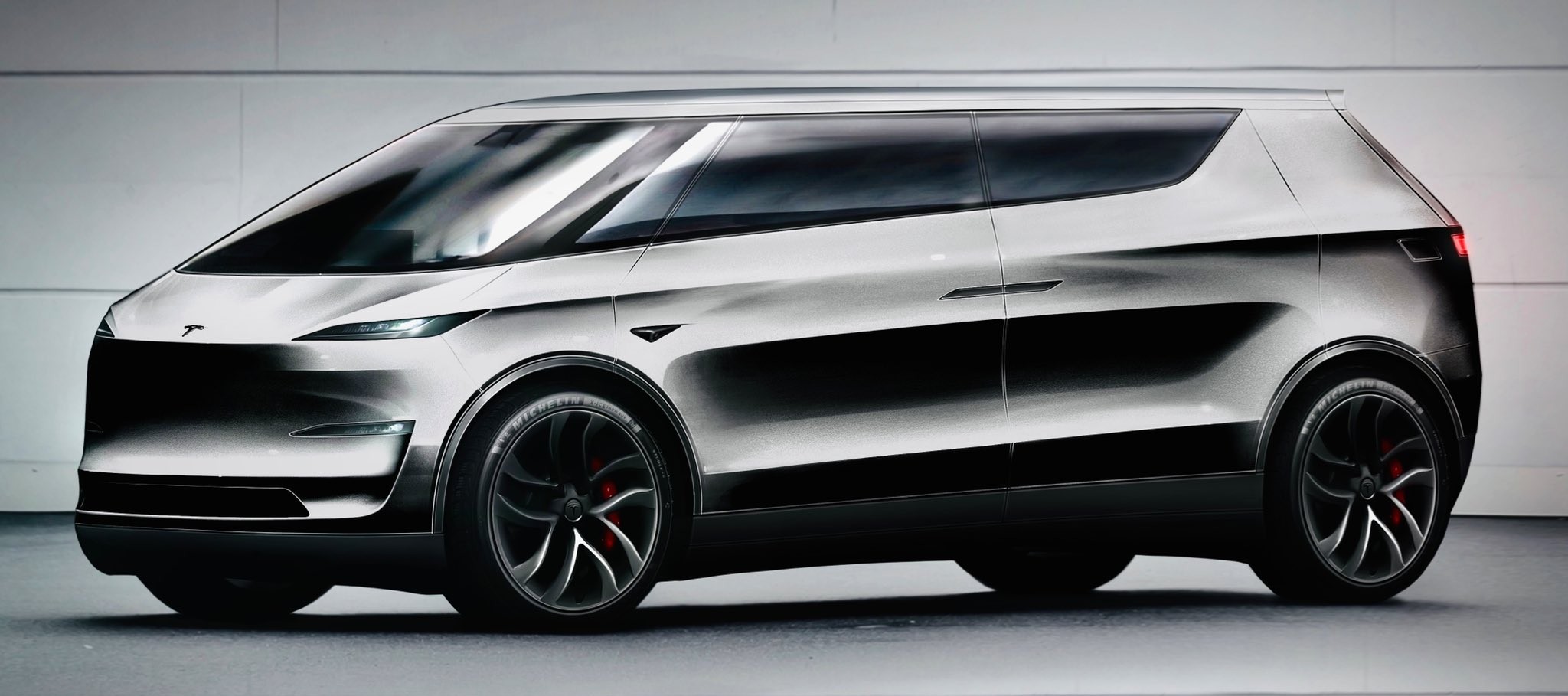
Tesla launched a slightly longer version of the Model Y all-electric crossover in China, and with it being extremely likely that the vehicle will make its way to other markets, including the United States, fans are still looking for something more.
The new Model Y L in China boasts a slightly larger wheelbase than its original version, giving slightly more interior room with a sixth seat, thanks to a third row.
Tesla exec hints at useful and potentially killer Model Y L feature
Tesla has said throughout the past year that it would focus on developing its affordable, compact models, which were set to begin production in the first half of the year. The company has not indicated whether it met that timeline or not, but many are hoping to see unveilings of those designs potentially during the Q3 earnings call.
However, the modifications to the Model Y, which have not yet been officially announced for any markets outside of China, still don’t seem to be what owners and fans are looking forward to. Instead, they are hoping for something larger.
A few months ago, I reported on the overall consensus within the Tesla community that the company needs a full-size SUV, minivan, or even a cargo van that would be ideal for camping or business use.
Tesla is missing one type of vehicle in its lineup and fans want it fast
That mentality still seems very present amongst fans and owners, who state that a full-size SUV with enough seating for a larger family, more capability in terms of cargo space for camping or business operation, and something to compete with gas cars like the Chevrolet Tahoe, Ford Expedition, or electric ones like the Volkswagen ID.BUZZ.
We asked the question on X, and Tesla fans were nearly unanimously in support of a larger SUV or minivan-type vehicle for the company’s lineup:
🚨 More and more people are *still* saying that, despite this new, longer Model Y, Tesla still needs a true three-row SUV
Do you agree? https://t.co/QmbRDcCE08 pic.twitter.com/p6m5zB4sDZ
— TESLARATI (@Teslarati) July 16, 2025
Here’s what some of the respondents said:
100% agree, we need a larger vehicle.
Our model Y is quickly getting too small for our family of 5 as the kids grow. A slightly longer Y with an extra seat is nice but it’s not enough if you’re looking to take it on road trips/vacations/ kids sports gear etc.
Unfortunately we…
— Anthony Hunter (@_LiarsDice_) July 17, 2025
Had to buy a Kia Carnival Hybrid because Tesla doesn’t have a true 3 row vehicle with proper space and respectable range. pic.twitter.com/pzwFyHU8Gi
— Neil, like the astronaut (@Neileeyo) July 17, 2025
Agreed! I’m not sure who created this but I liked it enough to save it. pic.twitter.com/Sof5nMehjS
— 🦉Wise Words of Wisdom – Inspirational Quotes (IQ) (@WiseWordsIQ) July 16, 2025
Tesla is certainly aware that many of its owners would like the company to develop something larger that competes with the large SUVs on the market.
However, it has not stated that anything like that is in the current plans for future vehicles, as it has made a concerted effort to develop Robotaxi alongside the affordable, compact models that it claims are in development.
It has already unveiled the Robovan, a people-mover that can seat up to 20 passengers in a lounge-like interior.
The Robovan will be completely driverless, so it’s unlikely we will see it before the release of a fully autonomous Full Self-Driving suite from Tesla.
Energy
Tesla launches first Virtual Power Plant in UK – get paid to use solar
Tesla has launched its first-ever Virtual Power Plant program in the United Kingdom.

Tesla has launched its first-ever Virtual Power Plant program in the United Kingdom. This feature enables users of solar panels and energy storage systems to sell their excess energy back to the grid.
Tesla is utilizing Octopus Energy, a British renewable energy company that operates in multiple markets, including the UK, France, Germany, Italy, Spain, Australia, Japan, New Zealand, and the United States, as the provider for the VPP launch in the region.
The company states that those who enroll in the program can earn up to £300 per month.
Tesla has operated several VPP programs worldwide, most notably in California, Texas, Connecticut, and the U.S. territory of Puerto Rico. This is not the first time Tesla has operated a VPP outside the United States, as there are programs in Australia, Japan, and New Zealand.
This is its first in the UK:
Our first VPP in the UK
You can get paid to share your energy – store excess energy in your Powerwall & sell it back to the grid
You’re making £££ and the community is powered by clean energy
Win-win pic.twitter.com/evhMtJpgy1
— Tesla UK (@tesla_uk) July 17, 2025
Tesla is not the only company that is working with Octopus Energy in the UK for the VPP, as it joins SolarEdge, GivEnergy, and Enphase as other companies that utilize the Octopus platform for their project operations.
It has been six years since Tesla launched its first VPP, as it started its first in Australia back in 2019. In 2024, Tesla paid out over $10 million to those participating in the program.
Participating in the VPP program that Tesla offers not only provides enrolled individuals with the opportunity to earn money, but it also contributes to grid stabilization by supporting local energy grids.
-

 Elon Musk1 day ago
Elon Musk1 day agoWaymo responds to Tesla’s Robotaxi expansion in Austin with bold statement
-

 News1 day ago
News1 day agoTesla exec hints at useful and potentially killer Model Y L feature
-

 Elon Musk2 days ago
Elon Musk2 days agoElon Musk reveals SpaceX’s target for Starship’s 10th launch
-

 Elon Musk3 days ago
Elon Musk3 days agoTesla ups Robotaxi fare price to another comical figure with service area expansion
-

 News1 day ago
News1 day agoTesla’s longer Model Y did not scale back requests for this vehicle type from fans
-

 News1 day ago
News1 day ago“Worthy of respect:” Six-seat Model Y L acknowledged by Tesla China’s biggest rivals
-

 News2 days ago
News2 days agoFirst glimpse of Tesla Model Y with six seats and extended wheelbase
-

 Elon Musk2 days ago
Elon Musk2 days agoElon Musk confirms Tesla is already rolling out a new feature for in-car Grok

